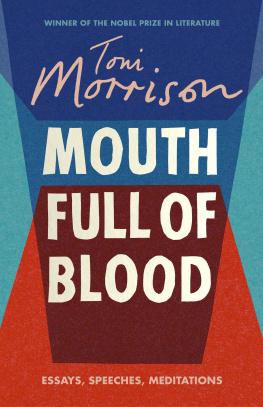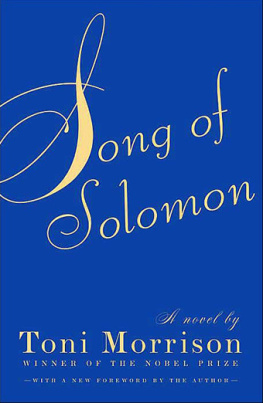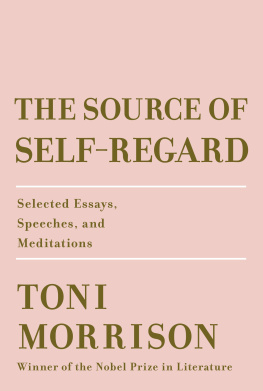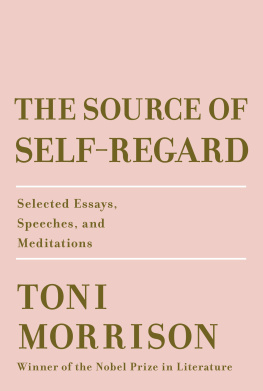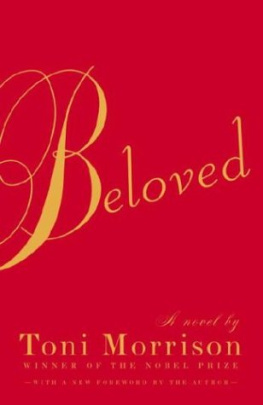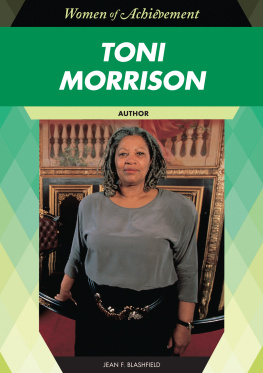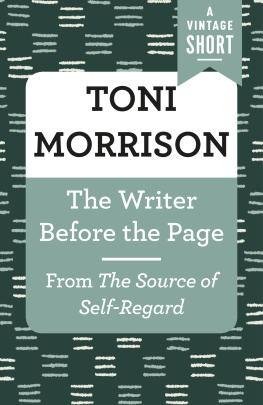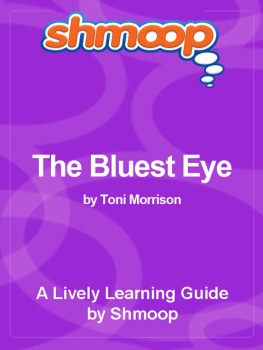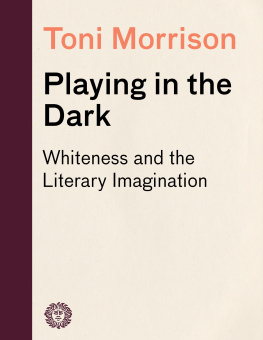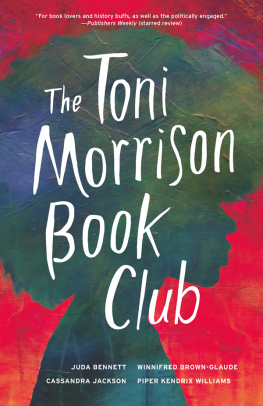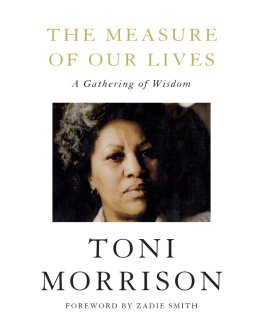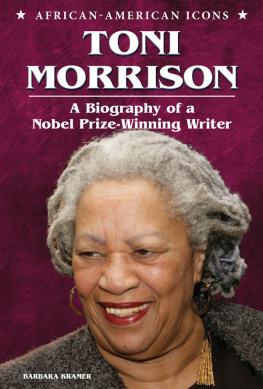Toni Morrison - The Bluest Eye
Here you can read online Toni Morrison - The Bluest Eye full text of the book (entire story) in english for free. Download pdf and epub, get meaning, cover and reviews about this ebook. year: 2007, publisher: Vintage, genre: Detective and thriller. Description of the work, (preface) as well as reviews are available. Best literature library LitArk.com created for fans of good reading and offers a wide selection of genres:
Romance novel
Science fiction
Adventure
Detective
Science
History
Home and family
Prose
Art
Politics
Computer
Non-fiction
Religion
Business
Children
Humor
Choose a favorite category and find really read worthwhile books. Enjoy immersion in the world of imagination, feel the emotions of the characters or learn something new for yourself, make an fascinating discovery.

- Book:The Bluest Eye
- Author:
- Publisher:Vintage
- Genre:
- Year:2007
- Rating:3 / 5
- Favourites:Add to favourites
- Your mark:
- 60
- 1
- 2
- 3
- 4
- 5
The Bluest Eye: summary, description and annotation
We offer to read an annotation, description, summary or preface (depends on what the author of the book "The Bluest Eye" wrote himself). If you haven't found the necessary information about the book — write in the comments, we will try to find it.
The Bluest Eye — read online for free the complete book (whole text) full work
Below is the text of the book, divided by pages. System saving the place of the last page read, allows you to conveniently read the book "The Bluest Eye" online for free, without having to search again every time where you left off. Put a bookmark, and you can go to the page where you finished reading at any time.
Font size:
Interval:
Bookmark:
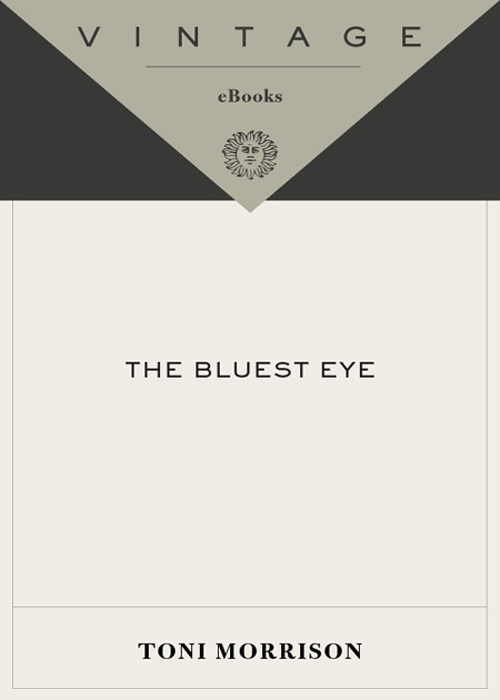
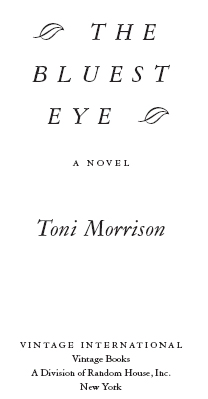
Contents
To the two who gave me life
and the one who made me free
Foreword
There cant be anyone, I am sure, who doesnt know what it feels like to be disliked, even rejected, momentarily or for sustained periods of time. Perhaps the feeling is merely indifference, mild annoyance, but it may also be hurt. It may even be that some of us know what it is like to be actually hatedhated for things we have no control over and cannot change. When this happens, it is some consolation to know that the dislike or hatred is unjustifiedthat you dont deserve it. And if you have the emotional strength and/or support from family and friends, the damage is reduced or erased. We think of it as the stress (minor or disabling) that is part of life as a human.
When I began writing The Bluest Eye, I was interested in something else. Not resistance to the contempt of others, ways to deflect it, but the far more tragic and disabling consequences of accepting rejection as legitimate, as self-evident. I knew that some victims of powerful self-loathing turn out to be dangerous, violent, reproducing the enemy who has humiliated them over and over. Others surrender their identity; melt into a structure that delivers the strong persona they lack. Most others, however, grow beyond it. But there are some who collapse, silently, anonymously, with no voice to express or acknowledge it. They are invisible. The death of self-esteem can occur quickly, easily in children, before their ego has legs, so to speak. Couple the vulnerability of youth with indifferent parents, dismissive adults, and a world, which, in its language, laws, and images, re-enforces despair, and the journey to destruction is sealed.
The project, then, for this, my first book, was to enter the life of the one least likely to withstand such damaging forces because of youth, gender, and race. Begun as a bleak narrative of psychological murder, the main character could not stand alone since her passivity made her a narrative void. So I invented friends, classmates, who understood, even sympathized, with her plight, but had the benefit of supportive parents and a feistiness all their own. Yet they were helpless as well. They could not save their friend from the world. She broke.
The origin of the novel lay in a conversation I had with a childhood friend. We had just started elementary school. She said she wanted blue eyes. I looked around to picture her with them and was violently repelled by what I imagined she would look like if she had her wish. The sorrow in her voice seemed to call for sympathy, and I faked it for her, but, astonished by the desecration she proposed, I got mad at her instead.
Until that moment I had seen the pretty, the lovely, the nice, the ugly, and although I had certainly used the word beautiful, I had never experienced its shockthe force of which was equaled by the knowledge that no one recognized it, not even, or especially, the one who possessed it.
It must have been more than the face I was examining: the silence of the street in the early afternoon, the light, the atmosphere of confession. In any case it was the first time I knew beautiful. Had imagined it for myself. Beauty was not simply something to behold; it was something one could do.
The Bluest Eye was my effort to say something about that; to say something about why she had not, or possibly ever would have, the experience of what she possessed and also why she prayed for so radical an alteration. Implicit in her desire was racial self-loathing. And twenty years later, I was still wondering about how one learns that. Who told her? Who made her feel that it was better to be a freak than what she was? Who had looked at her and found her so wanting, so small a weight on the beauty scale? The novel pecks away at the gaze that condemned her.
The reclamation of racial beauty in the sixties stirred these thoughts, made me think about the necessity for the claim. Why, although reviled by others, could this beauty not be taken for granted within the community? Why did it need wide public articulation to exist? These are not clever questions. But in 1962 when I began this story, and in 1965 when it began to be a book, the answers were not as obvious to me as they quickly became and are now. The assertion of racial beauty was not a reaction to the self-mocking, humorous critique of cultural/racial foibles common in all groups, but against the damaging internalization of assumptions of immutable inferiority originating in an outside gaze. I focused, therefore, on how something as grotesque as the demonization of an entire race could take root inside the most delicate member of society: a child; the most vulnerable member: a female. In trying to dramatize the devastation that even casual racial contempt can cause, I chose a unique situation, not a representative one. The extremity of Pecolas case stemmed largely from a crippled and crippling familyunlike the average black family and unlike the narrators. But singular as Pecolas life was, I believed some aspects of her woundability were lodged in all young girls. In exploring the social and domestic aggression that could cause a child to literally fall apart, I mounted a series of rejections, some routine, some exceptional, some monstrous, all the while trying hard to avoid complicity in the demonization process Pecola was subjected to. That is, I did not want to dehumanize the characters who trashed Pecola and contributed to her collapse.
One problem was centering the weight of the novels inquiry on so delicate and vulnerable a character could smash her and lead readers into the comfort of pitying her rather than into an interrogation of themselves for the smashing. My solutionbreak the narrative into parts that had to be reassembled by the readerseemed to me a good idea, the execution of which does not satisfy me now. Besides, it didnt work: many readers remain touched but not moved.
The other problem, of course, was language. Holding the despising glance while sabotaging it was difficult. The novel tried to hit the raw nerve of racial self-contempt, expose it, then soothe it not with narcotics but with language that replicated the agency I discovered in my first experience of beauty. Because that moment was so racially infused (my revulsion at what my school friend wanted: very blue eyes in a very black skin; the harm she was doing to my concept of the beautiful), the struggle was for writing that was indisputably black. I dont yet know quite what that is, but neither that nor the attempts to disqualify an effort to find out keeps me from trying to pursue it.
My choices of language (speakerly, aural, colloquial), my reliance for full comprehension on codes embedded in black culture, my effort to effect immediate coconspiracy and intimacy (without any distancing, explanatory fabric), as well as my attempt to shape a silence while breaking it are attempts to transfigure the complexity and wealth of Black American culture into a language worthy of the culture.
Thinking back now on the problems expressive language presented to me, I am amazed by their currency, their tenacity. Hearing civilized languages debase humans, watching cultural exorcisms debase literature, seeing oneself preserved in the amber of disqualifying metaphorsI can say that my narrative project is as difficult today as it was then.
The Bluest Eye

Font size:
Interval:
Bookmark:
Similar books «The Bluest Eye»
Look at similar books to The Bluest Eye. We have selected literature similar in name and meaning in the hope of providing readers with more options to find new, interesting, not yet read works.
Discussion, reviews of the book The Bluest Eye and just readers' own opinions. Leave your comments, write what you think about the work, its meaning or the main characters. Specify what exactly you liked and what you didn't like, and why you think so.

